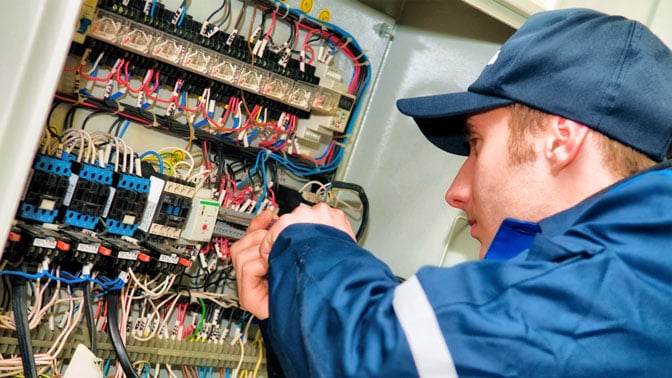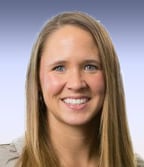This post was written by Nichole Angiola, OEM adjustable frequency drive product manager of Eaton's Control Power and Conversion Division.
Energy efficiency is on everyone’s mind. Energy efficiency is the ability to reduce the energy footprint of a system or process and ultimately save costs. End users feel the pressure of cost reduction and energy efficiency in different ways. Utility companies are charging more for high usage during high-demand periods, and the penalties are getting more costly. Regulations and legislations are creating requirements for energy-efficiency programs in companies as well. The energy-related products (ErP) legislation in Europe demands variable frequency drives to be used on every IE2 (high efficiency class) motor if an IE3 (premium efficiency) motor is not used. In California, Title 24 requires frequency control on fans in the heating, ventilation, and air conditioning (HVAC) segment. These demands are reaching down to original equipment manufacturers (OEMs) and panel builders.

As variable frequency becomes a larger requirement in systems, adjustable frequency drives (AFD) are becoming very common in the industrial control market. On smaller systems and lower power range systems, the AFD has caused a lot of pain. The danger is that the AFD may be overkill for the application. A drive causes long installation processes and cumbersome commissioning, as a drive typically has more than 100 parameters. Many applications are basic—simple fans, small motors, conveyors, or pumps. These applications typically do not require advanced parameter setting and should have basic and simple installation and commissioning.
Soft starters use a different technology and can only control the starting and stopping of the motor, fan, or pump. These devices are generally easier to install and less expensive than an adjustable frequency drive, but they lack the ability to change the frequency and speed of the system. Soft starters do not require advanced commissioning. In fact, most users select the unit per the motor’s voltage and current ratings, install the units, and press the start button without messing with any other parameter.
How can a user get the benefits of a drive while enjoying the simplicity of a soft starter? How can a panel builder and user reduce the complexity of the control panel while still meet energy-efficiency demands?
There are three aspects to consider when building a panel around an adjustable frequency drive: application, wiring, and commissioning.
When considering motor control, there are many options on how to control a motor, fan, pump, etc. Contactors start and stop motors. Starters start and stop motors with overload protection. Soft starters add a smooth ramp up and ramp down during starting and stopping. Drives do all of this with adjustable frequency and advanced motor and device protections. Drives have the highest growth in the market due to the pressure for energy efficiency. They are used more and more in many applications.
Application considerations
AFDs are used in many diverse applications, from fan walls to warehouse conveyors to booster pumps. Applications can have very basic motor control.
- In the HVAC market segment, there are thousands of fans that only follow an input that changes the speed of the fan dependent on the environment and temperature. These applications only use an analog input or a fixed frequency value to control the fan.
- Conveyor motors follow references from sensors of when to turn on or off. Drives are used to handle the additional torque that is seen on the motor when starting up a loaded conveyor more smoothly and safely.
These examples are basic applications that require adjustable frequency, but that are typically burdened with long installation and commissioning.
Using products that have default control terminal operation that matches the basic application requirements can reduce the installation and commissioning time. (An example is a variable speed starter, which combines the advantages of an adjustable frequency drive and a starter.) If you have a simple application, use products that have the required parameters already set up as defaults. This means that there is no required additional commissioning to set up the system. Selecting the proper drive can save time and money when paying attention to the application.
Variable speed starters typically are designed without keypads. This can hinder an application, such as needing to adjust parameters after commissioning, but it can also create a cost-effective and simplistic control panel design. Many drive users do not want operators to have access to the keypad in case parameters are changed, which can adversely affect the system. Once the control panel door is shut, the keypad on a drive becomes useless or redundant. Using a keypad-less variable speed starter can reduce the control panel complexity and cost.
Applications with multiple motors in a control cabinet require a motor control component and upstream circuit protection for each motor. An example system is a fan wall with 10 fans. This requires 10 motors, 10 drives, and 10 circuit breakers or fuses and results in a larger control panel to accommodate the additional components, wiring, and heat dissipation. Considering a drive that has been UL tested for group motor installation can reduce those three things.
Group motoring allows for up to five drives controlling five motors to be protected by one upstream short-circuit device. Drives that are rated for group motoring typically have common accessories that link the mains wiring of each drive properly. There are significant savings in material cost, installation time, and complexity. In the example of 10 fans on a fan wall, the user will see these benefits:
- Reducing the number of circuit protection devices from 10 to two
- Reducing the time and complexity of wiring the system—point-to-point wiring from each circuit protection device to each drive
- Reducing the panel size as the number of components and wiring is reduced
- Promoting a clean, simplistic panel design
Wiring considerations
The AFD’s physical layout can lead to a wiring consideration. There are two different layouts for the line and load wires: (1) line, load, and control wiring through the bottom of the drives and (2) contactor-like wiring where the line-side wiring is located at the top of the drive, the load-side wiring is at the bottom of the drive, and the control wiring is on the face of the drive. Drives with contactor-like wiring have easier wiring and a less complex wiring diagram.
Reversing contactors and starters are used in many applications in which adjustable frequency is not required but changing the direction of the motor or fan is required. These control components typically require additional wiring to meet the electrical reversing requirements, mechanical interlocking to eliminate both reversing and nonreversing signals to the motor, and additional space as the products are mounted side by side. Products like the variable speed starter and other drives can eliminate the additional wiring and mechanical interlock while reducing the panel space required.
Commissioning considerations
Setting the parameters of a drive adds additional time for commissioning and installation. Copy/paste tools are the easiest and most efficient way to set up the parameters of the drive. These tools have many beneficial functions:
- They can copy the parameter set from one drive to the next if a system like a fan wall has identical fans and configurations.
- They can store parameters to maintain the parameter set for a different application configuration. For example, if an HVAC system has a cooling fan and compressor, the copy/paste modules can store the parameters for the individual fan and compressor application with labels of the application name.
- They can be used to easily replace down or failed drives. The user can pull the parameters from the failed drive and then easily and quickly install the new drive for reduced downtime. Just the same, the OEM or panel builder can send out a copy/paste module to a customer’s site for inexpensive and quick troubleshooting.
These tools can easily decrease the complexity of installing, commissioning, and troubleshooting systems.
For basic applications, there are a few parameters that may need to be changed from defaults, such as the ramp time, motor rated current, motor frequency, fixed frequency, or the control terminal configuration. The user can easily change these parameters by going through the keypad parameter menu or using the PC tools. There is another configuration tool that can make this process quicker and easier with just a screwdriver. This intuitive configuration module has dials and a switch to change these basic parameters.
There are many considerations when building a control panel around an adjustable frequency drive. By considering the application before selecting the drive, you can reduce wiring time, commissioning time, and material cost such as with group motor applications. Wiring consideration is another piece of the puzzle, but selecting products that improve the wiring diagram and wire complexity will help make a more effective panel. Using tools to quicken the commissioning time will alleviate the stressful burden of repetitive setup and installation. With the continued advancement of technology and products, more tools will become available to help reduce the complexity that surrounds adjustable frequency requirements.
About the Author Nichole Angiola is the OEM adjustable frequency drive product manager of Eaton's Control Power and Conversion Division in Menomonee Falls, Wis. She is responsible for OEM, HVAC, and industrial application solutions, with a focus on harmonics reduction and increased system energy efficiency. Angiola received her B.S. in mechanical engineering from Oakland University in Rochester Hills, Mich.
Nichole Angiola is the OEM adjustable frequency drive product manager of Eaton's Control Power and Conversion Division in Menomonee Falls, Wis. She is responsible for OEM, HVAC, and industrial application solutions, with a focus on harmonics reduction and increased system energy efficiency. Angiola received her B.S. in mechanical engineering from Oakland University in Rochester Hills, Mich.
A version of this article also was published at InTech magazine.



